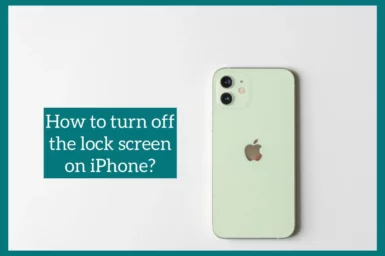Every time you pick up your iPhone, do you find yourself having to swipe or input your passcode repeatedly? Despite being essential to security, the lock screen might occasionally seem inconvenient.
In this article, we will demonstrate how to disable the lock screen on your iPhone to speed up your iPhone experience while maintaining security.
Why Turn Off the Lock Screen?
For several reasons, turning off the lock screen on your iPhone can be a wise decision. The first benefit is that you no longer must frequently unlock your device during the day, saving you valuable time.
Second, it can be especially helpful when you’re at home or in a trusted area, where convenience overcomes the requirement for security. To guarantee that your data is kept secure, it is important to find the ideal balance between accessibility and security.
Methods to Turn Off Lock Screen on iPhone?
Depending on preferences and security, you can use a few different methods to disable the lock screen on your iPhone. The main techniques for disabling the lock screen are as follows:
1. Using Touch ID or Face ID
- If your iPhone supports Face ID, go to “Settings” > “Face ID & Passcode.”
- Type in your passcode.
- Toggle off “Require Attention for Face ID.”
- If your iPhone supports Touch ID, go to “Settings” > “Touch ID & Passcode.”
- Type in your passcode.
- Turn off “iPhone Unlock.”
With these settings disabled, your iPhone will unlock with just a glance or touch, removing the need for a lock screen.
2. Disabling Passcode
- Go to “Settings” > “Touch ID & Passcode” or “Face ID & Passcode” (if Face ID is enabled).
- Scroll down and click “Turn Passcode Off.”
- Type in your passcode.
- Disabling the passcode can unlock Your iPhone without a code or a biometric scan.
3. Auto-Lock Settings
- Go to “Display & Brightness” or “Display & Sound” under “Settings.”
- Toggle “Auto-Lock” to “Never.”
- Setting Auto-Lock to “Never” effectively removes the lock screen by keeping your iPhone’s screen on until you manually put it to sleep.
It’s important to remember that while these techniques make the device more convenient, they also make it less secure. If your iPhone holds important data, take care when deactivating lock screen security. Always keep your privacy and security requirements in mind when making this choice.
Potential Drawbacks to Consider
While disabling the iPhone’s lock screen can be convenient, there are several potential downsides and hazards to take into account before doing so:
1. Security Issues
The biggest disadvantage is that your device’s security has been compromised. Anyone with physical access to your iPhone without a lock screen can readily view your personal information, messages, apps, and settings.
If your mobile device is lost or stolen, this poses a serious risk. Disabling the lock screen might also raise privacy issues because anyone who picks up your phone can view your personal data without your permission.
2. Unintentional Action
Without a lock screen, it is simpler to unintentionally make calls, send messages, or carry out other actions while the phone is in your pocket or bag.
3. Battery Drain
Disabling the auto-lock option on your iPhone may cause the screen to stay on all the time, which increases power drain and drastically shortens your device’s battery life.
4. Accidental Modifications
Without a lock screen, you run the risk of accidentally deleting apps, changing settings, or altering the configuration of your device while it’s in your pocket or bag.
5. Potential Data Loss
Without a lock screen, there is a greater risk of unintentionally deleting or changing crucial data or apps.
6. Security Flaws
If you use your iPhone for work or store important company data, removing the lock screen could leave your employer’s information vulnerable to intrusion.
Conclusion
In conclusion, disabling your iPhone’s lock screen is convenient, but it also poses serious security and privacy dangers. Striking a balance between accessibility and protecting personal information is essential. To successfully protect your device and sensitive information, always evaluate your unique needs and consider different security solutions.




